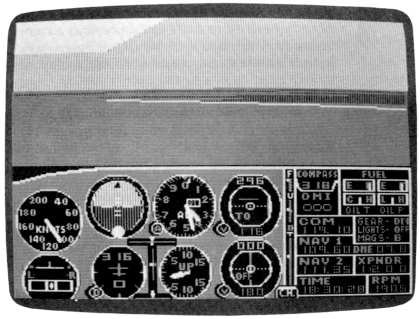40 More Great Flight Simulator Adventures
by Charles Gulick

Upstairs
Downstairs
Spanaway II
Downstairs
Spanaway II
| North Position: 20941 | Throttle: 20480 (all except IBM) |
| East Position: 6395 | Rudder: 32767 |
| Altitude: 2200 | Ailerons: 32767 |
| Pitch: 0 (IBM only) | Flaps: 0 |
| Pitch: 359 (all except IBM) | Elevators: 32767 (IBM) |
| Bank: 0 | Elevators: 34815 (Apple) |
| Heading: 280 | Elevators: 36863 (64 and Atari) |
| Airspeed: 115 (IBM only) | Time: 18:00 |
| Airspeed: 120 (all except IBM) | Season: 3-Summer |
| Throttle: 20479 (IBM only) | Wind: 4 Kts, 160 |
 |
You're inbound for Spanaway
Airport (not Shady Acres, where we took off
in the previous adventure, and which is also in the city of Spanaway).
Let's learn some new precision control techniques in flight. Tune your NAV to McChord OMNI, 109.6, which is only a couple of miles from Spanaway Airport. Your DME will show you how far out you are. Center the OBI needle to fly TO the station, and get on that heading. Important: When you bank the airplane more than a few degrees, give one notch of up elevator to maintain your altitude. Then take off the notch as you level your wings. While enroute, we're going to explore a superior method of altitude control, starting with a shallow climb. Experiment freely with the following procedures. |
|
 |
The 250 fpm climb is useful when you want to make a small adjustment upward in altitude. Note that airspeed remains virtually constant. And though the Piper in particular, hunts and pecks quite a while to figure out what it's supposed to be doing, the use of power, rather than back pressure on the yoke, provides a far greater degree of precision and much less wallowing around. If you need proof of this while flying the Piper, get straight and level and-looking out your left or right side-give one notch of up elevator. Note the violent changes in attitude. See how they register in wild swings of your VSI. And watch your airspeed indicator make like a pendulum until your VSI finally settles on about 250 fpm up. The same thing happens in the opposite direction when you take off the notch of elevator you added. These contortions are not nearly as pronounced in the Cessna, but power in both cases provides far more precise control. The point is that the aircraft will pitch naturally as a result of the power applied-pitch follows power. Think of the throttle as your altitude control. Let's demonstrate this a few more ways. |
|
 |
Again, airspeed remains virtually constant, and climb, once established, is very stable. |
|
 |
|
|
 |
Try the altitude adjustments described above a number of times until you feel comfortable with them. Try getting the same results with elevator trim adjustments, and decide for yourself which you like better-altitude control with pitch, with power, or with pitch plus power. If you wind up liking power best, with pitch changes only where a specific power setting won't yield the desired vertical speed or hold a specific altitude, welcome to the group. It includes a lot of pilots. (But then, so does the other philosophy. At least now you have a philosophy, whether or not it embodies something called Absolute Truth.) After you've practiced these ascents and descents, continue your flight to Spanaway if you like, or move right on to the next adventure. In the next Spanaway adventures, we'll see how power works equally well in transitioning to pattern altitude; then we'll take a look at airspeed and how to control it deftly. But before we do that, we'll take a little detour around two strange phenomena, one visible from only the Piper and the other only from the Cessna. Don't worry-no one is cheated-everyone winds up with 40 adventures. |
Table of Contents | Previous Section | Next Section
